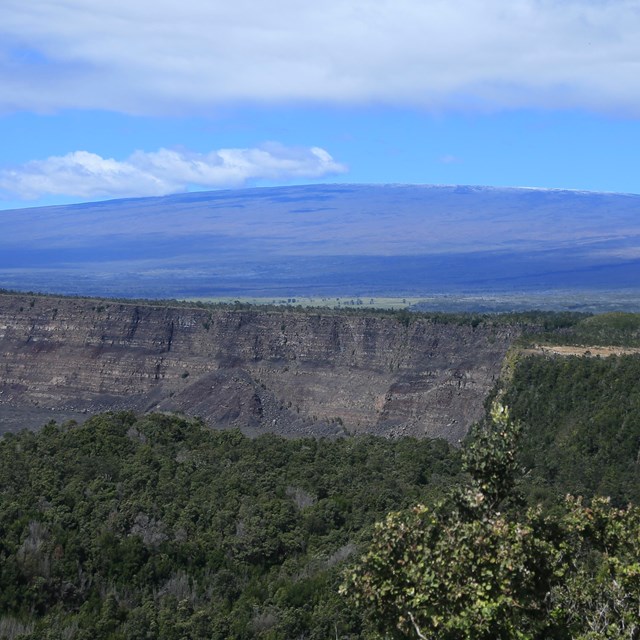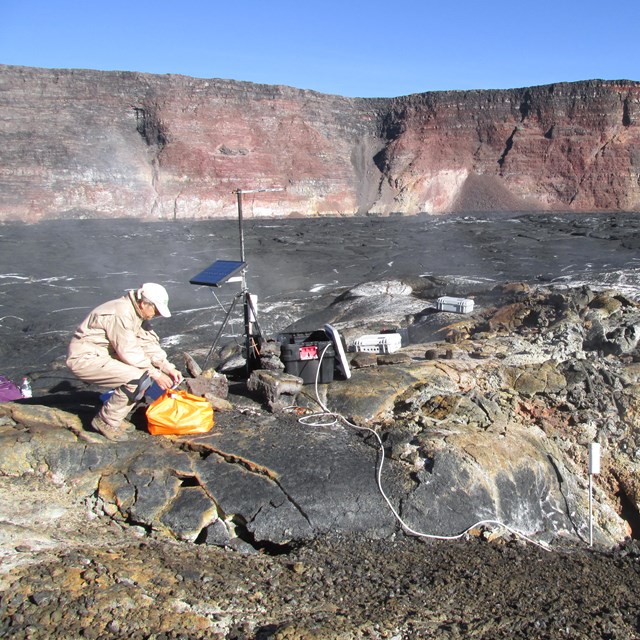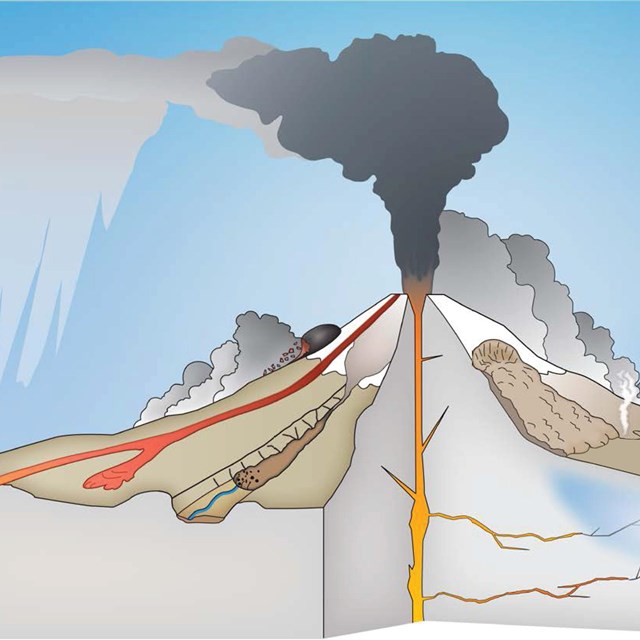
NPS photo.
Introduction
National parks are great places to experience the range of terrestrial volcanic landforms. For example, visitors to Mount Rainier can be inspired by a majestic composite volcano. At Capulin Volcano National Monument, visitors can walk around the rim and into the crater of a cinder cone.
Some parks only contain only one type of volcano, or even a single volcano. Other parks have multiple volcanoes within their boundaries, sometimes of multiple types.
Based on the number of different types of volcanoes it contains, Yellowstone National Park has the most volcanic diversity of any unit of the National Park System as it contains 6 different types of volcanoes. Aniakchak, Katmai, and Wrangell-St. Elias national parks and preserves in Alaska each contain 5 different types of volcanoes.
Crater Lake National Park is the second most diverse volcanic park in the Lower 48 as it contains 5 different types of volcanoes. Lassen Volcanic National Park and Lava Beds National Monument, both in Northern California, each contain 4 different types of volcanoes.
Explore Park Volcano Types
| Park | State | Cinder Cone | Composite Volcano | Shield Volcano | Caldera | "Super Volcanoes" | Dome | Tuff Ring/Maar | Fissure Volcano | Volcanic Field (Monogenetic) |
|---|
Learn More
Explore Parks with Volcanoes
-
Aniakchak National Monument (ANIA), Alaska—[ANIA Geodiversity Atlas] [ANIA Park Home] [ANIA npshistory.com]
-
Bandelier National Monument (BAND), New Mexico—[BAND Geodiversity Atlas] [BAND Park Home] [BAND npshistory.com]
-
Bering Land Bridge National Preserve (BELA), Alaska—[BELA Geodiversity Atlas] [BELA Park Home] [BELA npshistory.com]
-
Big Bend National Park (BIBE), Texas—[BIBE Geodiversity Atlas] [BIBE Park Home] [BIBE npshistory.com]
-
Capulin Volcano National Monument (CAVO), New Mexico—[CAVO Geodiversity Atlas] [CAVO Park Home ] [CAVO npshistory.com]
-
Coronado National Monument (CORO), Arizona—[CORO Geodiversity Atlas] [CORO Park Home] [CORO npshistory.com]
-
Crater Lake National Park (CRLA), Oregon—[CRLA Geodiversity Atlas] [CRLA Park Home] [CRLA npshistory.com]
-
Craters of the Moon National Monument (CRMO), Idaho—[CRMO Geodiversity Atlas] [CRMO Park Home] [CRMO npshistory.com]
-
Death Valley National Park (DEVA), California & Nevada—[DEVA Geodiversity Atlas] [DEVA Park Home] [DEVA npshistory.com]
-
El Malpais National Monument (ELMA), New Mexico—[ELMA Geodiversity Atlas] [ELMA Park Home] [ELMA npshistory.com]
-
Gila Cliff Dwellings National Monument (GICL), New Mexico—[GICL Geodiversity Atlas] [GICL Park Home] [GICL npshistory.com]
-
Grand Canyon National Park (GRCA), Arizona—[GRCA Geodiversity Atlas] [GRCA Park Home] [GRCA npshistory.com]
-
Grand Canyon-Parashant National Monument (PARA), Arizona—[PARA Geodiversity Atlas] [PARA Park Home] [PARA npshistory.com]
-
Haleakala National Park (HALE), Hawaii—[HALE Geodiversity Atlas] [HALE Park Home] [HALE npshistory.com]
-
Hawai’i Volcanoes National Park (HAVO), Hawai’i—[HAVO Geodiversity Atlas] [HAVO Park Home] [HAVO npshistory.com]
-
Kalaupapa National Historical Park (KALA), Hawai’i—[KALA Geodiversity Atlas] [KALA Park Home] [KALA npshistory.com]
-
Katmai National Park (KATM), Alaska—[KATM Geodiversity Atlas] [KATM Park Home] [KATM npshistory.com]
-
Lake Clark National Park and Preserve (LACL), Alaska—[LACL Geodiversity Atlas] [LACL Park Home] [LACL npshistory.com]
-
Lake Mead National Recreation Area (LAKE), Arizona and Nevada—[LAKE Geodiversity Atlas] [LAKE Park Home] [LAKE npshistory.com]
-
Lassen Volcanic National Park (LAVO), California—[LAVO Geodiversity Atlas] [LAVO Park Home] [LAVO npshistory.com]
-
Lava Beds National Monument (LABE), California—[LABE Geodiversity Atlas] [LABE Park Home] [LABE npshistory.com]
-
Mojave National Preserve (MOJA), California—[MOJA Geodiversity Atlas] [MOJA Park Home] [MOJA npshistory.com]
-
Mount Rainier National Park (MORA), Washington—[MORA Geodiversity Atlas] [MORA Park Home] [MORA npshistory.com]
-
National Park of American Samoa (NPSA), American Samoa—[NPSA Geodiversity Atlas] [NPSA Park Home] [NPSA npshistory.com]
-
Petrified Forest National Park (PEFO), Arizona—[PEFO Geodiversity Atlas] [PEFO Park Home] [PEFO npshistory.com]
-
Petroglyph National Monument (PETR), New Mexico—[PETR Geodiversity Atlas] [PETR Park Home] [PETR npshistory.com]
-
Saguaro National Park (SAGU), Arizona—[SAGU Geodiversity Atlas] [SAGU Park Home] [SAGU npshistory.com]
-
Santa Monica Mountains National Recreation Area (SAMO), California—[SAMO Geodiversity Atlas] [SAMO Park Home] [SAMO npshistory.com]
-
Sunset Crater Volcano National Monument (SUCR), Arizona—[SUCR Geodiversity Atlas] [SUCR Park Home] [SUCR npshistory.com]
-
Valles Caldera National Preserve (VALL), New Mexico—[VALL Geodiversity Atlas] [VALL Park Home] [VALL npshistory.com]
-
Wrangell-St. Elias National Park and Preserve (WRST), Alaska—[WRST Geodiversity Atlas] [WRST Park Home] [WRST npshistory.com]
-
Yellowstone National Park (YELL), Wyoming—[YELL Geodiversity Atlas] [YELL Park Home] [YELL npshistory.com]
-
Zion National Park (ZION), Utah—[ZION Geodiversity Atlas] [ZION Park Home] [ZION npshistory.com]
Reference
-
Walkup, L.C., T.J. Casadevall, and V.L. Santucci, 2017. Born of Fire: In Search of Volcanoes in U.S. National Parks, Four Striking Examples. Earth Sciences History Vol. 36, No. 2, 2017 pp. 197–244. https://irma.nps.gov/DataStore/Reference/Profile/2247733
Last updated: April 20, 2023



